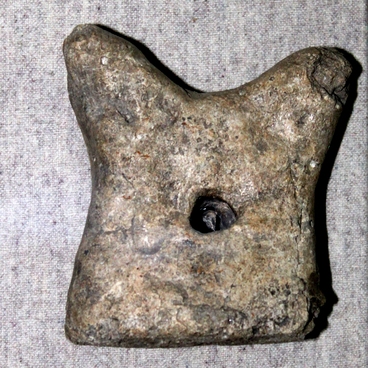Boar tusk amulet with a scratched inscription was discovered in the vicinity of a chronicle city Vschizh. A village by the same name is located in its place now. Archaeologist Boris Rybakov led the excavations in the area. Remains of an ancient sanctuary and an orthodox cathedral of pre-Mongol times were excavated in the area of the ancient Vschizh.
Boar tusk amulet
Время создания
XII–XIII centuries
Техника
Bone, engraving
Коллекция
Выставка
1
Открыть в приложении#1
Boar tusk amulet
#2
#3
Ancient Slavs used amulets made of animal tusks as talismans. They were most often worn by men: according to old beliefs, a talisman gave its owner health, strength and courage, protected from enemies, chased away evil spirits and brought luck in hunting and in battle. Sometimes men wore strings of amulets: they were believed to act stronger together.
#4
Tusk talismans were usually worn around the neck and fixed on a chain or thin rope. Historian and archaeologist Boris Rybakov commented on that custom:
#5
‘The abundance of symbolic decorative talismans near the collar of clothes and on the neck is explained by the fact that this is the least protected part of the body. The head is covered <…>, the body and legs <…> are covered by clothes made with wide use of talismanic phrases, while the neck remained exposed in all cases’.
#7
Boar tusk amulet with inscription
#6
The Vschizh amulet displayed in Bryansk Ethnography Museum was made in the XII or XII century. A part of the tusk was cut off to produce an even surface that was then polished. On this place an unknown artist made the engraving: ‘God, help thy servant Foma’. The inscription was made according to the ‘hard’ canon — a clear angular handwriting, with the letters having almost no protruding elements above and below. The remaining surface of the tusk was not treated, preserving its natural texture with lateral grooves.
The talisman from the ‘Bryansk Antiquities’ collection is a graphic example of Slavic dual belief system. After ancient Rus was baptized, many tribes worshipped Christ and pagan idols at the same time. Ancient symbols were getting a new meaning. For instance, lunula — the symbol of fertility — signified the Holy Virgin during the dual faith period, and slat talismans were associated not only with the gods of fire and sun, but also with Christ. The same happened with the boar tusk from Vschizh: a Christian prayer was inscribed on a pagan talisman.
#8
State budgetary cultural institution Bryansk State Regional Ethnography Museum
читать дальшескрыть
00:00
00:00
1x
Boar tusk amulet
Время создания
XII–XIII centuries
Техника
Bone, engraving
Коллекция
Выставка
1
Открыть в приложении
Поделиться

